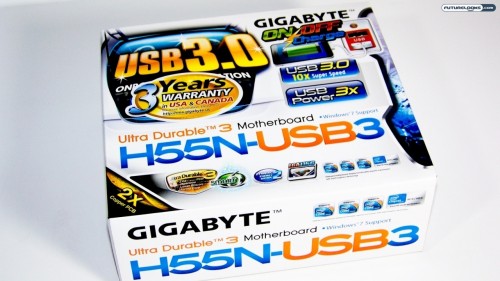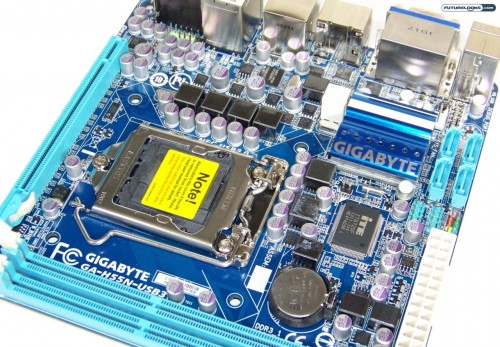
Smaller is sometimes better especially when efficiency and innovation are two primary focuses. Mini-ITX motherboards are one of the latest ideas that some what follows along that focus. While it doesn’t take creative thinking to produce one, the features that pack the little board does take a little effort. With limited space, picking and choosing the right features can make or break the end result. We know GIGABYTE is pretty good at the big stuff. But, how are they at m-ITX motherboards? Let’s have a look at the H55N-USB3 Mini-ITX and answer that question together.
Features and Specifications

The GIGABYTE H55N-USB3 sports the Ultra Durable 3 platform improvements necessary to support Dynamic Energy Saver 2 and secure an ErP certification to satisfy European Union regulations. It also fully supports the entire line of Intel LGA1156 processors, in particular the Core i3 and i5 with integrated graphics processors and of course Intel Turbo Tech. GIGABYTE adds two other features like Cloud OC and Hotkey OC. That in itself suggests the board can do more than just a casual turbo increase. If all that overclocking goes wrong, you got Dual BIOS to save your neck.
Since it supports processors with integrated graphics and the latest expansion features, you’ll find a VGA, DVI, and HDMI 1.4a port out. There’s also two blue USB 3.0 ports as these come in very handy if one was to use this in an home theater PC. The board omits SATA3 and sticks to offering 4 onboard SATA2 ports along with 1 rear eSATA port. A single full speed PCIE x16 slot will come in handy for any graphics card.
The integrated audio gets a full sized boost with a Realtek ALC892 codec which has proven to be an upper echelon cost effective high definition solution and also has an SPDIF optical out. Quality of implementation we will later decide during testing.
At a humble $95 to $105 USD, it could be just what you need in time for the holiday season.
Video Unboxing and Walkthrough
Some of us like the hands on approach when looking motherboards over. I found the layout of the H55N-USB3 to be pretty neat and tidy. Have a look for yourself.
That’s a pretty packed little mini-ITX motherboard. Why we don’t call them “miniboards” is something that has crossed my cavernous cranium. You probably also noticed the board doesn’t offer integrated WiFi. Could that be a problem for some users looking to make things a little more portable? Let’s test it and find out.
Testing Notes and System Setup
We’ll be putting the GIGABYTE up against the ZOTAC H55ITX-C-E (no more letters please), which is probably its closest competition in the market and we’ll be looking closer at this board in a future review. I’m pretty convinced that the ZOTAC favors a user who want WiFi and portability while the GIGABYTE is tuned for enthusiasts with a little more on their mind besides stock performance.
Test System Hardware:
- Processor: Intel Core i5-655K LGA1156 Processor
- Motherboard 1: GIGABYTE H55N-USB3 (as tested)
- Motherboard 2: ZOTAC H55ITX-C-E
- Memory: Kingston HyperX LOVO 4GB 1800MHz DDR3 Dual Channel
- Graphics: ZOTAC Geforce GTX480 Videocard
- OS Storage: Kingston 128GB SSDNow V+
- USB 3.0 Enclosure: Rosewill RX-358-U3B w/WD Caviar 2TB Black HDDn
- Power Supply and Enclosure: Silverstone SG07 and Watt SST-ST60F-SG (600W)
- Operating System: Windows 7 Professional 64-Bit
Note that the latest Intel INF (4/29/2010)chipset, Realtek Azalia r2.49-6121 audio, NEC 2.0.4.0. USB 3.0, and Intel VGA 2104 drivers were installed. The motherboard’s latest F5 BIOS was also update was patched. Onward with the benchmarking!
Benchmark Configuration
The software benchmark suite consists of CPU and motherboard intensive titles to tax all of the sub systems: 3DMark Vantage, PCMark Vantage, CineBench R11.5, GraySky x.264 Encoding, Unigine Heaven Demo V2.0, Games: Battlefield Bad Company 2, Crysis, SANDRA Network, SANDRA CPU Math and Multimedia.
CrystalDiskMark was used to test USB 2.0 and 3.0 performance accompanied by a Rosewill RX-358-U3B external enclosure containing a Western Digital 2TB Caviar Black SATA2 hard drive. A Seagate 7200.10 500GB SATA2 hard drive was used in testing SATA2 performance.
